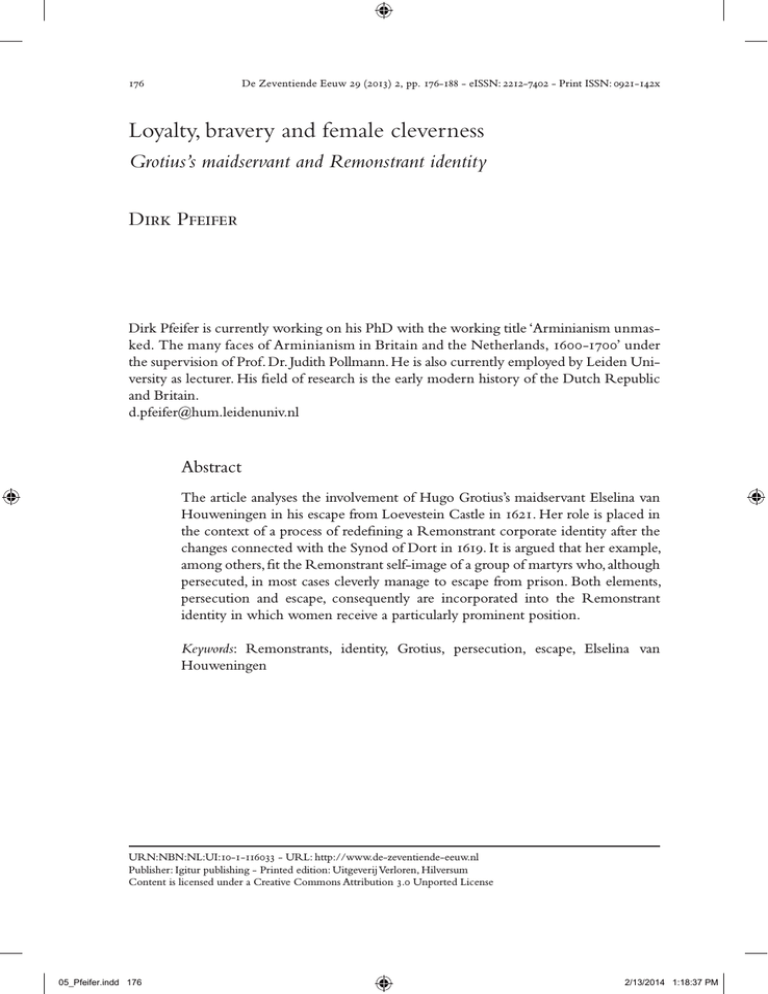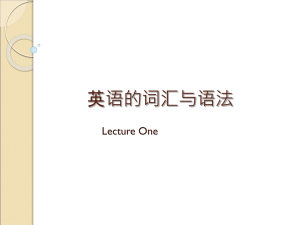Loyalty, bravery and female cleverness
advertisement

De Zeventiende Eeuw 29 (2013) 2, pp. 176-188 - eISSN: 2212-7402 - Print ISSN: 0921-142x 176 Loyalty, bravery and female cleverness Grotius’s maidservant and Remonstrant identity Dirk Pfeifer Dirk Pfeifer is currently working on his PhD with the working title ‘Arminianism unmasked. The many faces of Arminianism in Britain and the Netherlands, 1600-1700’ under the supervision of Prof. Dr. Judith Pollmann. He is also currently employed by Leiden University as lecturer. His field of research is the early modern history of the Dutch Republic and Britain. d.pfeifer@hum.leidenuniv.nl Abstract The article analyses the involvement of Hugo Grotius’s maidservant Elselina van Houweningen in his escape from Loevestein Castle in 1621. Her role is placed in the context of a process of redefining a Remonstrant corporate identity after the changes connected with the Synod of Dort in 1619. It is argued that her example, among others, fit the Remonstrant self-image of a group of martyrs who, although persecuted, in most cases cleverly manage to escape from prison. Both elements, persecution and escape, consequently are incorporated into the Remonstrant identity in which women receive a particularly prominent position. Keywords: Remonstrants, identity, Grotius, persecution, escape, Elselina van Houweningen URN:NBN:NL:UI:10-1-116033 - URL: http://www.de-zeventiende-eeuw.nl Publisher: Igitur publishing - Printed edition: Uitgeverij Verloren, Hilversum Content is licensed under a Creative Commons Attribution 3.0 Unported License 05_Pfeifer.indd 176 2/13/2014 1:18:37 PM Loyalty, bravery and female cleverness177 Loyalty, bravery and female cleverness Grotius’s maidservant and Remonstrant identity Dirk Pfeifer On 8 March 1681 a woman of about eighty years was buried in the Nieuwe Kerk in The Hague. Her name was Elselina van Houweningen. During her life she had not only experienced an impressive rise in her social status but also played an important role in what was probably the most adventurous escape of the Dutch Golden Age. She had begun her career at the start of the seventeenth century as a young girl in the service of the famous Rotterdam pensionary, Hugo Grotius (de Groot), and his wife, Maria van Reigersbergh. As their maidservant, she shared in the fate of her master and mistress when Grotius was arrested, accused of treason, tried, and then imprisoned in Loevestein Castle from 1619 to 1621. Later she married the notary Willem Cornelisz. van Velden, living in The Hague until her death in 1681, where she had joined the local Remonstrant community. Elselina van Houweningen had started off as a simple maidservant, yet after her death she left a legacy which can easily be described as extraordinary and which lasted throughout the eighteenth and nineteenth centuries. This legacy had its origin in her role during Hugo Grotius’s celebrated escape in 1621 from Loevestein Castle. In the course of this cunning escape, Elselina showed extraordinary loyalty, bravery and cleverness.1 In this paper I want to focus on three points: firstly, I will describe Grotius’s escape from prison and especially his maidservant’s role in carrying out the plan. Secondly, I will shed light on the efforts of the Remonstrants to memorialize Grotius’s escape by reshaping the story to their own ends. Thirdly, I will place Elselina’s involvement in the escape from Loevestein in the specific context of the creation of a Remonstrant identity in the seventeenth and eighteenth centuries. Loyal care of Grotius’s maidservant: Elselina and the book chest After Grotius had been imprisoned at Loevestein Castle and had spent almost two years there, his wife Maria van Reigersbergh came up with the idea of ‘smuggling’ 1 M. Smits-Veldt, ‘Houweningen, Elselina van’, in: Digitaal Vrouwenlexicon van Nederland. url: http://www. historici.nl/Onderzoek/Projecten/dvn/lemmata/data/Houweningen (accessed on 14 January 2013). I am especially grateful to Dr. Glyn Redworth (University of Manchester) and Sara Pelgar for their suggestions and corrections to this article. 05_Pfeifer.indd 177 2/13/2014 1:18:37 PM 178 Dirk Pfeifer her husband out of the fortress in a book chest. From Grotius’s biography, publish­ed by Caspar Brandt and Adriaan van Cattenburgh, we learn all the details of this adventurous escape.2 Elselina played an essential part in this cunning plan since the book chest was to be entrusted to her as soon as it had left the castle. When Grotius and Van Reigersbergh revealed the plan to Elselina, and especially her own role in the plot, we get the impression from Brandt and Cattenburgh that the young girl at first hesitated while she pondered the possible consequences before finally consenting.3 From this moment on we perceive Elselina as a courageous and committed servant who is ultimately willing to take risks for the benefit of her master and mistress, and by doing so she transcends the boundaries between masters and servants by showing a clear personal affection to Grotius and his wife to the point of neglecting her own safety. Conversely, she receives a responsibility that exceeds her position as a maidservant and her particularly young age. In the course of the narrative of the escape, this is further accentuated by placing Elselina – or Elsje, as she is often called – in the position of the main character while the real central figure must remain hidden in a book chest (fig. 1). The plan is carried out on Monday, 22 March 1621. Grotius hides early in the morning in the book chest, remaining as calm as possible. The chest is carried down by guards who already utter suspicions about the unusual weight of the box. One of them even makes a funny remark about drilling a hole in the chest right into what would have been the hidden Grotius’s rear, to which Elsje calmly responds by saying he would need a drill that reached from there all the way to Grotius’s room where he still lay sleeping.4 Judging from the account of Brandt and Cattenburgh this might have calmed the suspicions of the guards to some extent since there are apparently no more remarks by them. Once the chest has arrived at the pier ready to be loaded onto the ferry to Gorcum, Elsje’s loyal care for the safety of Hugo Grotius is further commented upon. She takes care that the skipper of the boat uses a solid plank to load the heavy chest so that ‘the borrowed expensive books’ cannot be spoiled by the water.5 In a similar way, she confidently requests that the chest be secured with ropes, and when one of the soldiers travelling with them dares to sit on Grotius’s chest and keeps swinging his feet against it, she kindly asks him to go away, as otherwise, so she claims, the porcelain in the chest could easily break.6 During the whole journey Elsje appears to her fellow travellers as a loyal and committed young girl who confidently manages to take the responsibility 2 C. Brandt and A. van Cattenburgh, Historie van het Leven des Heeren Huig de Groot, Dordrecht, Amsterdam 1727, p. 242-252. 3 Ibidem, p. 244: ‘Zy zeide, ja, en vraegde tevens, zou men my ook eenig quaet konnen doen, als ik’t gedaen heb? De Groot antwoordde, niet naer rechten, maer ik ben ook onschuldig, en ge ziet echter hoe men met my handelt. Waer op de dienstmaegt zich verluiden liet, ik zal ’t evenwel wagen, daer kome af wat het wil’. 4 Ibidem, p. 245. 5 Ibidem, p. 246: ‘Wat zal dit zyn? zultge op zoo dunnen plank het koffer in het schip slepen? zoo doende zou ’t licht in ’t water vallen, dan was alles bedorven. ’t Zyn kostelyke boeken, die geleent zyn en daer zorg voor dient gedragen’. 6Ibidem. 05_Pfeifer.indd 178 2/13/2014 1:18:37 PM Loyalty, bravery and female cleverness179 Fig. 1 Albertus Anthonius Nunnink, Hugo Grotius prays together with his wife Maria van Reigersberg and his maidservant Elsje van Houweningen prior to the escape in the book chest, 22 march 1621, 1853-1855, rp-p-ob-80.943, Rijksmuseum Amsterdam. for the entrusted task to transport a chest with goods, while to the reader she appears as a committed young girl who cleverly counters all contingencies of the journey with a suitable – though not always consistent – explanation, thus demonstrating her loyalty to Grotius and the plot to rescue him. The final act of her involvement takes place in Gorcum. After the ferry has arrived, she once more secures that the chest is carried instead of being loaded onto a pushcart in order to be taken immediately to its destination. Again she provides explanations which counter all possible suspicions by the porters, but when one of the boys carrying the chest feels Grotius moving inside the wooden box, he exclaims: ‘Father, there is something alive inside this chest!’ Elsje remains calm at this sudden threat of being exposed and at first ignores the remark but eventually replies: ‘Yes, books bear spirit and are very much alive’.7 With this remark she saves Grotius and the success of the 7 Ibidem, p. 247: ‘Terwyl Grotius zich onder ’t draegen eens verlei en verschikte, zei de Zoon, Vader, daer leeft iets in het koffer.Waer op de Schipper tot de Dienstmaegt zeide, Elsje hoort gy wel wat myn Zoon zeit? Zy geliet zich als of ze het niet hoorde. Hy daer op, hy zeit dat’er iets leeft in de kist. Zy, ja, boeken hebben geest en leven’. 05_Pfeifer.indd 179 2/13/2014 1:18:39 PM 180 Dirk Pfeifer plan for one last time before the chest arrives at its destination where Grotius can finally escape confinement, dress up as a mason, and leave for the Spanish Netherlands and eventually France (fig. 2). Elselina had fulfilled her task faithfully and cunningly, wiping out all suspicion from those involved in the passage of the book chest from Loevestein to Gorcum. She had created the impression that there really was nothing suspicious about the chest and so managed to convince all those involved with its transport. Her tender age, represented also in her naïve remarks, might have supported this impression and it could even be possible that this was one of the major reasons why Elsje was selected for this important task. Naturally, Maria van Reigersbergh needed to remain behind in order to support the illusion that she would stay with her still sleeping husband while Elselina was entrusted with the task of delivering the chest. But Elselina’s loyalty, cleverness and apparent simple-mindedness perfectly qualified her to deal with the most important element in the plan. Consequently, her role in the success of the escape plot was essential, which is why it featured so prominently in Brandt’s and Van Cattenburgh’s account. She received a position similar to that of Maria van Reigersbergh who is clearly identified by Brandt and Van Cattenburgh as the mastermind behind the plan. However, since she could not be physically present during the transport of her Fig. 2 Caspar Jacobsz Philips, Escape of Hugo Grotius in the book chest from Loevestein Castle, 1621, 17451789, rp-p-ob-80.938, Rijksmuseum Amsterdam. 05_Pfeifer.indd 180 2/13/2014 1:18:40 PM Loyalty, bravery and female cleverness181 husband, Elselina, to some extent, took her position while Van Reigersbergh remained only spiritually present. In the biography of Grotius this is expressed by including her earnest prayers and concerns about the safety of her husband into the escape story. To understand why Elsje is granted this rather prominent position in the narrative of the escape, it is important to know more about the reception of the escape but also about the sources which Brandt and Van Cattenburgh used for their account and how they came to be collected. Marital fidelity, the cunning of love and the male bravery of females: the reception of Grotius’s escape Even though Grotius’s escape from prison must have been spectacular news, there is not much evidence that it was publicly perceived as such in its immediate aftermath. In April 1621 a pamphlet appeared in Antwerp that only briefly summarized the circumstances of his escape from Loevestein. Apart from the inattentiveness of the guards at the fortress it mainly stressed the role of Maria van Reigersbergh and almost completely ignores Elsje’s role in the plot.8 Afterwards, Grotius himself contributed to the reception of his escape through a poem in Dutch which eventually was published in a collection of verse in the early 1650s.9 In this poem, which he presumably wrote shortly after his arrival in Paris, he exclusively praises his wife for her ingenuity. Shortly afterwards, in 1632, Joost van den Vondel joined Grotius in writing another poem entitled ‘The deliverance of Hugo Grotius’, but this was only published in 1644, and once again placed Maria van Reigersbergh at the centre of attention.10 There were certainly several reasons why these early instances of reception of the escape focused mainly on Grotius’s wife while keeping Elsje’s involvement either in the background or even completely ignoring it. In the first place, it can be assumed that Elselina’s role during the escape had not been widely known to the public until she revealed it personally to the Remonstrant historiographer Geeraert Brandt a few years before her death. Furthermore, Elselina’s social status as a maidservant did not justify according her a prominent place in the escape; instead, she was placed in her mistress’s shadow precisely because it was her mistress who had the necessary ingenuity and social rank to take on this public role of a heroine. And finally, even if her involvement in the escape of 8 Cort verhael hoe subtyl en vvonderlyck Mr Hvgo Grotivs Pensionaris der Stadt Rotterdam Met een Koffer wt zijne Ghevanckenisse te Loevesteyn in Hollant, ghedraghen, ende voorder ontkomen is, Antwerp 1621, Kn(uttel collection) 3186a, see W.P.C. Knuttel (ed.), Catalogus van de Pamfletten-verzameling berustende in de Koninkijke Bibliotheek Den Haag, vol. viii, The Hague 1916. This pamphlet was published anonymously and was signed V.C.D.W.A. 9 H. de Groot, ‘Aen sijn Huisvrouw M. Reygersberch, over sijn verlossingh uyt deeuwige gevangenis’, in: H. de Groot et al., Verscheyde Nederduytsche gedichten, Amsterdam 1651, p. 103-105. 10 J. van den Vondel, Hekeldichten. Met de aanteekeningen der ‘Amersfoortsche’ uitgave, uitgegeven en toegelicht door J. Bergsma, Zutphen s.a., p. 2-3. 05_Pfeifer.indd 181 2/13/2014 1:18:40 PM 182 Dirk Pfeifer Grotius was known among a smaller and more local audience, Elsje was probably also deliberately omitted in order to protect her from possible persecution by the Dutch authorities and to safeguard her future livelihood. Probably the first detailed report of the escape which also talks about the involvement of both Maria van Reigersbergh and Elselina as her servant can be found in a work published in 1661 by Petrus de Lange. His Batavise Romeyn is a collection of several heroic stories in Dutch history dating from the fifteenth century to the year of publication in 1661. Under the heading ‘female dexterity’ Grotius’s escape from Loevestein is listed as number one hundred in the collection.11 Despite the short account – the whole description comprises less than five pages – De Lange provides many details of the planning and execution of the escape, including some significant dialogues of those involved in it.12 Once again, Maria van Reigersbergh features prominently, which leads to the conclusion that the title refers more to her involvement than to that of her maidservant Elselina. Nonetheless, Elsje’s participation is at least recognized by De Lange when he repeatedly refers to her as ‘the maid’ and occasionally attributes cleverness to her for her care about how the book chest was handled.13 Elselina van Houweningen finally broke through into public recognition of her part in Grotius’s book-chest escape only long after her death, with the publication of the aforementioned biography of Grotius by Caspar Brandt and Adriaan van Cattenburgh in 1727. The apparent delay, however, was not intentional but rather the result of a series of misfortunes which hindered the publication of this biography. As a matter of fact, interest in Elsje’s pro-active involvement in Grotius’s escape can be traced back to her lifetime, to the year 1675. At that time, as annotations in the biography reveal, the man behind the idea of producing a biography of Grotius, Geeraert Brandt, began collecting information concerning the famous book-chest escape from Loevestein. We learn that he received first-hand information from Elselina herself, who obviously described her role in the story and told it to Brandt. The famous Remonstrant historiographer consequently planned to use her memories to complement his other sources which he had been collecting. Among those were extracts from Grotius’s correspondence with Gerard Vossius in 1621 and annotations by the Remonstrant Eduard Poppius.14 Unfortunately, the sudden death of Geeraert Brandt in 1685 prevented him from finishing Grotius’s biography. In the following years, his son Caspar, however, took up his father’s plans and began working on the biography project again.15 Since the annotations in the escape story speak literally of an eyewitness report that was given 11 P. de Lange, Batavise romeyn ofte Alle de voornaemste heldendaden, ridderlijke feyten en listige oorlogsvonden, in veld en zeeslagen […] by de Hollanders en Zeeuwen verricht, zedert den jare 1492 tot 1661, Amsterdam 1661, p. 145148. I am very grateful to Dr. Erika Kuijpers and her students of the Master Seminar ‘Heroism in the Dutch Revolt’ at Leiden University during the academic year 2011 for bringing this source to my attention. 12 Unfortunately, De Lange does not reveal the sources on which he based his information. 13 De Lange, Batavise romeyn, p. 147: ‘dan de loose meyt/sey: Daer zijn kostelijcke dingen in, die mochten breken: draeght het, ick sal ’t u wel betalen’. 14 Brandt and Cattenburgh, Leven Huig de Groot (n. 2), p. 244. 15 Smits-Veldt, ‘Houweningen’ (n. 1). 05_Pfeifer.indd 182 2/13/2014 1:18:40 PM Loyalty, bravery and female cleverness183 to Geeraert Brandt we can conclude that his son Caspar was responsible for the editing of this particular part of the biography.16 Since some of the facts provided for the escape story resemble the description provided earlier by Petrus de Lange, we can even assume that Caspar Brandt either used De Lange as source without explicitly mentioning him, or both editors relied on the same sources. Despite all his efforts, Caspar Brandt could not complete his father’s work as fate struck again. When Caspar died at the age of 43 in 1696 the biography had still not seen the light of day. The project, however, seemed to be of significance to the Remonstrant Brotherhood, and so the Remonstrant scholar and teacher at the seminary in Amsterdam, Adriaan van Cattenburgh, completed it and published the biography in 1727 under the title of Historie van het Leven des Heeren Huig de Groot (History of the Life of Hugo de Groot). With its completion, almost 50 years after the death of Elselina van Houweningen, her active involvement in Grotius’s escape from Loevestein Castle had at last become publicly known. Apparently, the publication of the biography triggered a revival of interest in the eighteenth century not only for Grotius but also for the two women involved in his escape. In particular, Maria van Reigersbergh once again became the centre of attention with a series of books and plays that commemorated her role in the plot. Her ‘marital fidelity’ proven by her care for Hugo Grotius represented the virtues of a good wife, whilst ‘the cunning of love’ emphasized the honest and passionate motivation of both Maria and Hugo in the initiation and execution of their plan. Eventually, writers like Frederik Duim, Adriaan Loosjes and later H.A. Spandaw, dedicated books and plays to these characteristics above all of Maria van Reigersbergh. Additionally, Elsje van Houweningen’s prominent role in Grotius’s escape was reflected in a growing interest in her virtues. While Caspar Brandt might have referred specifically to her when he mentioned ‘the male bravery of females’ in his introductory words to the escape story, this extraordinary bravery was idealized further in plays, schoolbooks and almanacs for women during the eighteenth and nineteenth centuries.17 Evidently, the prominent role which Elselina van Houweningen had received in Grotius’s biography by Brandt and Van Cattenburgh had developed into a historical legacy. This found its first climax in Adriaan Loosjes’s ’t Gedrag van Elsje van Houwening dienstmaagd van Huig Grotius geschetst, in eene aanspraak, which appeared in 1794 in Haarlem.18 It is clear that the publication of the biography placed Elselina van Houweningen into the spotlight of attention which she had not received during her lifetime. The question that has until now not satisfactorily been answered is, what Brandt actually motivated to include Elsje’s account so prominently in the escape story? One rather obvious reason was entirely pragmatic. In 1675 when Brandt had already collected 16 In the margin, it says: ‘Uit de mondtvertelling van Elsje van Houwening, Grotius dienstmaegt, aen myn zaligen Vader, in den Jaere 1675. gedaen’, Brandt and Cattenburgh, Leven Huig de Groot, p. 244. 17 M.B. Smits-Veldt, ‘Images of two 17th-century Dutch women. From 17th-century ideal to 19th-century myth’, in: The Canadian Journal of Netherlandic Studies 18.1 (1997), p. 19-28, spec. p. 22-24. 18 A. Loosjes, ’t Gedrag van Elsje van Houwening dienstmaagd van Huig Grotius geschetst, in eene aanspraak, Haarlem 1794. 05_Pfeifer.indd 183 2/13/2014 1:18:41 PM 184 Dirk Pfeifer various sources about the escape, Elselina van Houweningen was the only living eye-witness able to provide first-hand information. She was therefore predestined to feature prominently in the story. Another reason might have been her considerable rise in social status. From what we learn, Elselina followed her mistress into exile to Paris after they had both been released from Loevestein and remained in her and Hugo Grotius’s service for a number of years. In 1625 she married the lawyer ­Willem Cornelisz. van Velden, who had been a protégé of Grotius and had been in his service previously. Together they lived in The Hague, where they both had joined the local Remonstrant community.19 We can only assume that her loyalty to the Grotius family had been rewarded by them and made a marriage with Van Velden possible, which consequently resulted in a higher social status. After all, Elselina’s husband had been appointed civil law notary in 1625 and was admitted to the Hof van Holland in 1642 through which he had gained a considerable reputation.20 To refer to Elselina’s eye-witness report in the escape story therefore implied the use of a reliable and respectable source for Brandt, a source which evidently had also been closely associated with the Remonstrant Brotherhood. This must have provided enough reasons for Brandt to rely mainly on her memories in the retelling of the famous escape from Loevestein Castle. However, there was also another, more indirect, motivation for shifting the focus from Maria van Reigersbergh to Elselina van Houweningen. To understand this, it is necessary to place the reception of Grotius’s escape into the context of the creation of a Remonstrant identity in the course of the seventeenth century. Sad prisons and happy escapes: Elsje van Houweningen and the creation of a Remonstrant identity After the intervention of Prince Maurice in 1618 in the growing constitutional and political crisis of the Dutch Republic, Grotius was directly affected by the changing political and ecclesiastical context. With the arrest and trial of the Advocate of Holland Johan van Oldenbarnevelt and his execution in May 1619 he had lost his political support and faced life imprisonment at Loevestein Castle. Similarly, the Remonstrants in the Republic had lost their political support and faced their condemnation at the Synod of Dort and a period of persecution and exile. The Remonstrants countered what was in their eyes an unjustified attitude of the Dutch authorities by means of a process of organisational but also conceptual reorientation. They reorganised themselves as an independent church community in 1619 through the foundation of the Remonstrant Brotherhood in Antwerp. Consequently, they drew up their own confession and created a new and deliberately broad theological profile that was not set within the boundaries of confessionalised thinking but propagated a moderate and 19 Smits-Veldt, ‘Houweningen’. 20Ibidem. 05_Pfeifer.indd 184 2/13/2014 1:18:41 PM Loyalty, bravery and female cleverness185 tolerant approach towards religious minorities.21 Naturally, this reorientation was necessary because of the changed context and so the Remonstrants needed to redefine themselves. In the course of this, much of their past involvement and possible active intolerance towards the Contraremonstrants was forgotten because it did not fit into their new ideal of tolerance and moderation. The Remonstrants’ process of reinvention and redefining their identity involved the two major themes of persecution and escape which came to be prominently and publicly applied in the period after 1619. With the theme of persecution, individual Remonstrants publicly referred to the restrictions the Dutch authorities had laid upon them by comparing these measures to the persecution known throughout the history of Christianity, but particularly to the persecution experienced by most of the Dutch population during the Reformation and the Dutch Revolt. In the aftermath of the Synod of Dort, the Remonstrants tried to reactivate the memory of this injustice and appealed to a wider audience within Remonstrantism and outside of it to foster support for their cause. The programmatic application of moderation and tolerance became a central point in this appeal.22 In order to support their arguments further, they started to present themselves as martyrs who had come to suffer under persecution carried out by a rigorous group of ecclesiastics – i.e. the Contraremonstrants – and strict and often violent civil authorities. By applying the idea of martyrdom, the Remonstrants managed to create a connection between themselves and the early Dutch reformers who had achieved the creation of a broad church that encompassed differing theological interpretations. This determined, on the one side, their historical understanding and defined them as successors to these reformers while simultaneously presenting their opponents as deviating from the original idea and state of the Dutch church. On the other hand, the association with martyrs emphasized the righteousness of their cause and followed a longstanding Protestant tradition, built on biblical interpretation, where only the suffering church represents the true Christian church. Apparently, the Remonstrants also exploited the ecclesiastical and political circumstances of persecution for propagating their cause and creating their new profile in comparison to the other religious groups in the Republic. Primarily, they were the ones who faced persecution while Lutherans, Anabaptists and even Catholics had already found some modus vivendi with local and regional state authorities.That provided them with the unique chance to identify with the martyrs, whose sufferings had been salient and still evoked vivid memories in the minds of the Dutch anyway.23 21 G.J. Hoenderdaal and P.M. Luca, Staat in de vrijheid. De geschiedenis van de Remonstranten, Zutphen 1982. 22This becomes very obvious in the historiographic works of Johannes Uytenbogaert and Geeraert Brandt: J. Uytenbogaert, Kerckeliicke historie, Rotterdam 1647; G. Brandt, Historie der reformatie, en andere kerkelyke Geschiedenissen, in en ontrent de Nederlanden, 4 vols, Amsterdam 1674-1704. 23For the widespread popularity of martyr books in the Dutch Republic see A. Jelsma, Adriaan van Haemstede en zijn Martelaarsboek,The Hague 1970; B.S. Gregory, Salvation at stake. Christian martyrdom in early modern Europe, Cambridge (ma), London 2001, p. 139-196. 05_Pfeifer.indd 185 2/13/2014 1:18:41 PM 186 Dirk Pfeifer However, the Remonstrants’ identification with martyrdom faced the essential problem that barely any of their incarcerated ministers suffered great physical pain, let alone died for their cause. The only exception to this was Eduard Poppius, indeed a prominent minister of the Remonstrant Brotherhood, who died during imprisonment at Loevestein in 1624.24 The remaining prisoners were hardly ever treated as harshly as described in the martyrologies which circulated at the time. Nonetheless, the Remonstrants clung to that idea and incorporated it into their identity. Considering the achievements of the Republic in the Revolt against Spain and the very real experience of persecution, not even the Remonstrants might have expected a real return of inquisitorial practices in the Republic. Even so they realized that their treatment after 1619 could have marked an important setback in the development of the United Provinces and therefore it was their responsibility to warn the governments and the population about such developments. This at length necessitated an adaptation of the concept of martyrdom to the context in which the Remonstrants found themselves. This adaptation is represented through the theme of escape. In most cases, the Remonstrants after 1619 had to endure forms of persecutions but in almost all of these cases they also managed to evade those situations or even successfully escaped from them. Especially in the years between 1619 and 1623 there were numerous cases of Remonstrants who escaped imprisonment. The Remonstrant martyrs, rather than ending in death, ended in freedom again, which in turn was interpreted by them as the confirmation of the divine blessing of their cause and as a justification for the righteousness of their existence. Just like the apostles had done, the Remonstrants could flee and continue their service to God and their fellow brothers and sisters.25 In the light of these interpretations it was possible to apply the concept of martyrdom and combine it with the theme of escape. The latter then functioned as a replacement for the death of the martyr, and in several cases miraculous elements were included that were common in traditional accounts of martyrs. The adventurous escapes in this way replaced the miracles that were occasionally linked to earlier martyrs. Hugo Grotius’s escape in the book chest from Loevestein fits neatly into this interpretation. His cunning escape in March 1621 was not a singular incident but was paralleled in other Remonstrant escapes. A few months later, for instance, the Remonstrant minister Dominicus Sapma managed to flee from the Amsterdam prison disguised as his own wife. Several months after that, he even helped two of his colleagues to escape from the same prison and in 1631 the remaining imprisoned Remonstrants at Loevestein Castle managed to escape collectively from the fortress. All these incidents found expression in various forms of publications such as pamphlets, poems, songs or 24 A.Th. van Deursen, ‘Popius, Eduard’, in: D. Nauta et al. (eds), Biografisch lexicon voor de geschiedenis van het Nederlandse protestantisme, vol. 1, Kampen 1978, p. 260-261. 25 The apostles of the early Christian church had first been persecuted by the Sanhedrin and were then miraculously freed from prison by an angel, The Bible, Acts 5:17-26; Acts 12:1-19 (New International Version). 05_Pfeifer.indd 186 2/13/2014 1:18:41 PM Loyalty, bravery and female cleverness187 broadsheets.26 In those publications originating from the Remonstrant side, they contrasted the themes of persecution and escape and collectively built a complex of stories about sad prisons and happy escapes; two themes that were inseparably connected and formed eventually the centre of the Remonstrant identity after 1619. Most of these publications about successful escapes, however, also shared another important element: women played an essential role in the planning and execution of the escapes. As we have seen in the case of Hugo Grotius, Maria van Reigersbergh’s role in devising the plan to escape in the book chest is not contested in any of the publications retelling the story. Elselina van Houweningen’s involvement in the execution of it is, admittedly, appreciated at a later stage yet not questioned. In the case of Dominicus Sapma, the escape from his sad prison in Amsterdam is only made possible because his wife Grietje Ulbes sacrificed her own freedom and safety for her husband by remaining in the cell in his place so that he could pass the guards in her clothes. And in the case of the collective escape of all the remaining ministers from Loevestein in 1630 we are informed that their wives, who had been living with them there, also stayed behind at Loevestein in order to safeguard their passage in a boat from the fortress. Deservedly, the female role is recognized in the ensuing publications and the women are attributed with bravery, loyalty, cleverness and faithfulness. Most of these characteristics were usually ascribed to men at the time, but in the light of the circumstances the women took over the prominent male position. Therefore it is no surprise that Brandt describes Maria van Reigersbergh’s and Elselina’s actions in his introductory words to the escape story of Grotius as ‘male bravery of females’. Since the men in all of these stories are restricted in their freedom of action, the women take on their roles and so eventually get the chance to display their virtue. By exhibiting this, they automatically become role models and figures of identification for other Remonstrant women but also for all women in their time. Without going as far as calling the Remonstrant escape stories instances of female emancipation, they still prominently acknowledged the importance of women and might have deservedly paid tribute to them while simultaneously also pursuing a certain strategy. After all, women were central to the Remonstrant Brotherhood in the years after 1619 in the sense that they often formed an essential link between families and the respective Remonstrant congregation they belonged to. Men often had to sustain their families by getting public offices. A membership or any public association with the forbidden Remonstrant Brotherhood made this impossible and therefore often women became formal members of the Remonstrants. In this way they were essential in the formation of coherence among the Remonstrants as a group and needed to be particularly addressed. Furthermore, women could more easily play an active role in the escapes since they were usually punished less harshly than men. Therefore, the emphasis on the prominent parts of Maria van Reigersbergh, Elselina 26 D. Sapma, Droeve ghevanckenisse, ende blijde uytkomst, s.l. 1621; Anonymous, Blyde Wellekomst vande vrome borgeren tot Nieupoort, s.l. 1631; Anonymous, Triumph-lied ter eeren van Dominicus Sapmas Huysvrou die hem uut-geholpen heeft, s.l. 1621. 05_Pfeifer.indd 187 2/13/2014 1:18:41 PM 188 Dirk Pfeifer van Houweningen or Grietje Ulbes appear to be honest expressions of appreciation, but also strategic appeals to other women to follow their example and support the Remonstrant cause with virtuous actions. Elselina van Houweningen also fitted the ideal of a role model perfectly because of her social status. As a simple maidservant she could exemplify that members of her social rank were also capable of virtues commonly reserved to high-ranking people. As a result, she had developed a close personal relationship with her employers, that eventually led to a rise in her social status. Moreover, she had crossed social boundaries and could, consequently, serve as a role model for both lower and higher social classes. This might have been another motivation for Geeraert Brandt to visit her in 1675 in order to record her account of Grotius’s escape through which she finally received the attention her attitude and actions deserved. Despite the delay in publication of her involvement in the adventurous escape from Loevestein Castle, Elselina van Houweningen is an illuminating example of the creation of a Remonstrant identity in the seventeenth century. 05_Pfeifer.indd 188 2/13/2014 1:18:41 PM







